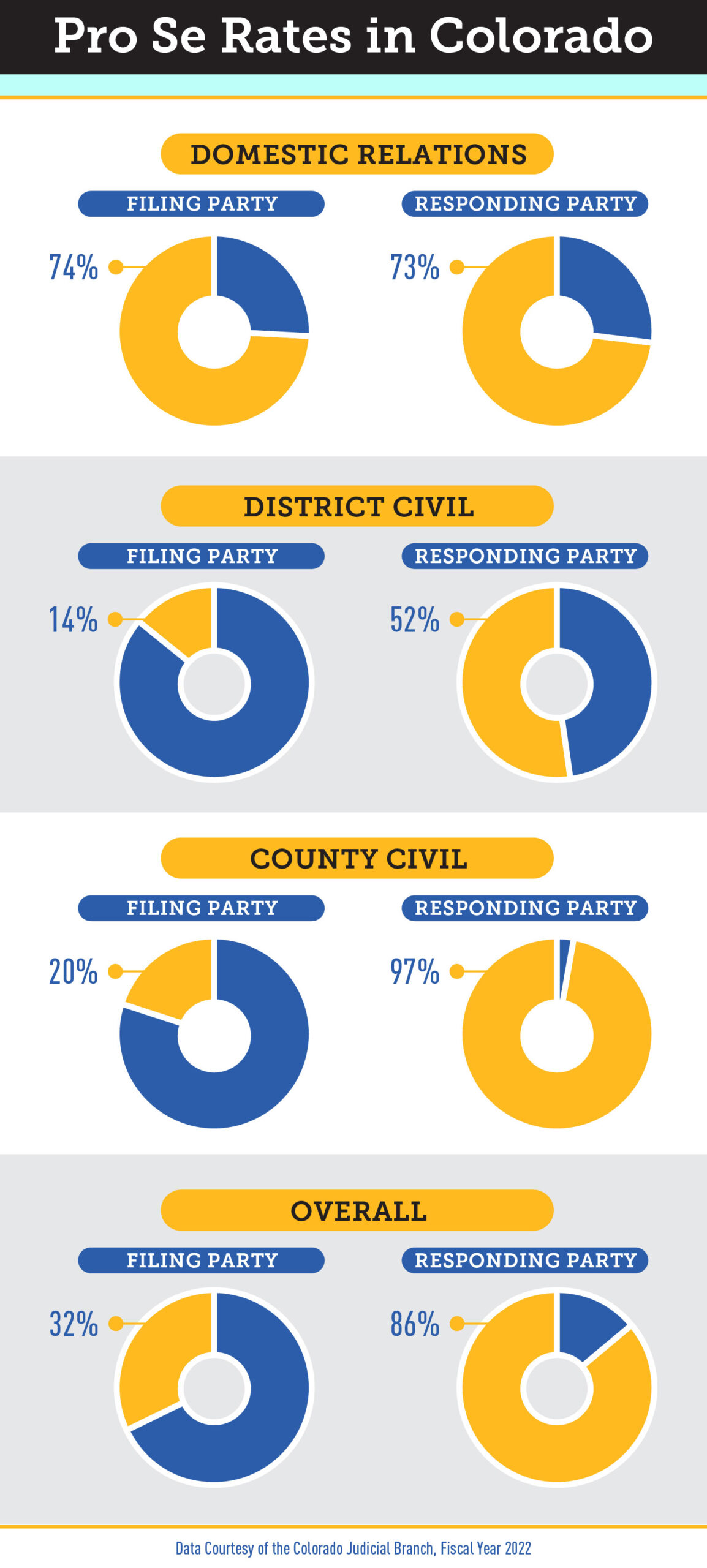Most Americans, whether from television, books or their education, know the phrase “you have a right to an attorney. If you cannot afford an attorney, one will be appointed for you.” While this phrase is true for defendants involved in criminal cases, the reality for Americans who find themselves in civil court is much different.
According to the American Bar Association, the right to counsel in civil matters “exists at present only in very limited circumstances.”
This lack of right to counsel creates problems for many Americans, particularly low-income individuals, who may not be able to afford an attorney. Coupled with the prevailing issue of legal deserts across the country and in Colorado, it leads to a stark rate of individuals who go to court without legal representation. In 2022, 86% of responding parties were without representation in civil cases in Colorado, according to data collected by the Colorado Judicial Branch.

The pro se rates in Colorado were notably better on the filing party side, with a pro se average of 32%. Notably, the pro-se rate for domestic relations cases was close on both sides of the courtroom, with a pro-se rate of 74% for filing parties and 73% for responding parties. The most extreme divide in representation was in county civil cases, with a pro se rate of 20% for filing parties and 97% for respondent parties.
There are groups across the country working to fill this gap, and one of the most notable groups are legal aid organizations, which were a focus of the American Bar Association’s 2023 Profile of the Legal Profession.
A Crucial Resource with Uneven Distribution
A lack of representation in civil cases is not a problem unique to Colorado. According to the 2022 Justice Gap report from the Legal Services Corporation, 92% of low-income Americans don’t receive adequate help for civil legal problems, and many don’t receive any help at all.
However, an individual’s location can play a significant part in their ability to find legal aid. The luckiest residents are those who live in New York, particularly New York City. According to the ABA survey, 1 out of 6 legal aid lawyers live in the state, with more than 1,000 living in New York City alone.
These numbers break down to 7.2 legal aid lawyers per 10,000 people in poverty, the highest in the country, according to the ABA report. On the flip side, Mississippi and South Carolina have a rate of 1.1 legal aid lawyers per 10,000 people in poverty. Colorado fairs a little better in the survey, with a 2.2 average per 10,000. However, Colorado sits below the national average of 2.8.
Another factor impacting access to legal aid resources across the country is the rural-urban divide. Metropolitan areas with more than a million residents, which contain 188 million people, or 57% of the nation’s population, contain 68% of the country’s paid legal aid lawyers. Rural areas, on the other hand, make up 14% of the population, but only 7% of paid legal aid lawyers live in them.
While there is currently a nationwide dearth of legal aid lawyers, the ABA report did note a bright spot. The number of legal aid lawyers in LSC-funded organizations has grown over the past nine years by 52%, from 4,306 to 6,542. These numbers are in addition to an estimated 4,300 attorneys in organizations not funded by LSC. Even with this growth, the report noted “there are still not nearly enough legal aid lawyers to help all the low-income families and individuals with civil legal problems.”
Diversity Continues to Steadily Grow in the Legal Profession
Last year’s ABA report spotlighted diversity on the federal bench, and this year’s showed another steady increase in diversity across the legal profession.
The percentage of female lawyers has risen 5% over the last decade, from 34% in 2013 up to 39% in 2023, according to the report. Given current demographic trends at law schools, the percentage will likely continue to rise. Women made up 55.7% of students pursuing a juris doctor degree at ABA-accredited law schools in 2022, continuing a six-year trend of women outnumbering men in law schools.
The ABA report also noted that the percentage of lawyers of color came close to doubling in the last decade, increasing from 11% to 21%. White lawyers are still over-represented in comparison to the US population at 78%, in contrast to making up roughly 59% of the population, but the gap is closing.
The most notable increases, in significant part due to California beginning to report the race and ethnicity of its lawyers, were in the representation of Asian-American and Hispanic lawyers. The percentage of Asian-American lawyers comes close to their share of the US population, at 6% compared to 6.3%, respectively.
The number of Hispanic lawyers also grew in the past decade, from 3.7% to 6%, but still remain underrepresented in relation to their share of the US population of 19.1%. The percentage of Black lawyers increased slightly over the past decade, moving from 4.8% to 5%. However, that number still remains significantly lower than their 13.6% share of the US population.
In addition to the growing diversity among attorneys is a continued growth of diversity in law schools. According to the ABA report, in 2022 one-third of law school students were people of color, an increase of 6% over the past decade.
If the trend lines remain the same, diversity in the legal community will continue to grow.